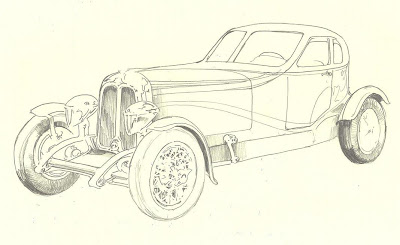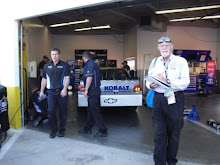Confessions of an addicted machiniac
Machiniac: one who is fascinated by the beauty of machines
and my addiction is to graphite, as it is propelled from a 0.5mm mechanical pencil
A sketch (self portrait) I did of a drawing session, sharing graphite with my youngest grandson, Cameron
As with any task, the proper tools are essential; here are a few of mine, ones that I made myself (machined on a lathe from solid pieces of aluminum bar stock).

While those pictured are my "home made" examples, my collection of mechanical pencils started with a drafting career in the late 1950's and I've been at it ever since. My collection numbers in the hundreds; many rare pencils bought on business trips to Japan and Germany, wonderful pieces of this art form that went out of production 25 years ago.
 My first attempt in the art business was making hand-drawn comic books in the first grade, and selling them to my fellow students (for their lunch money); enterprise aside, my efforts were not applauded by the school, or the parents of my customers (the other 1st grade students).
My first attempt in the art business was making hand-drawn comic books in the first grade, and selling them to my fellow students (for their lunch money); enterprise aside, my efforts were not applauded by the school, or the parents of my customers (the other 1st grade students).My father was an engineer and when the firm he worked for bought all new drafting tables he pulled a discarded drafting table from the company dumpster and brought it home for me, so from the age of 5 on I had my own "drawing studio:" the drafting table in a corner of the basement. Math was a game I played with my dad; he gave me his old math books and a slide rule as toys. It just never dawned on me that solving square roots and Pythagorean triangles wasn't how all second graders spent Saturday afternoons with their dad.
 By the sixth grade I was in serious risk of failing math; while everyone else was figuring out how to do simple division, I'd "invented" a base 36 number system (10 digits and 26 letters), made a slide rule (in my father's machine shop) that used this system and was busy doing trig problems with logarithms in my new numbering scheme. My math teacher thought I was just playing, and I most assuredly was not doing my long division homework,...let's see, 2 pages every night of problems like 18 divided by 6, etc., just wasn't holding my attention. Can't imagine why.
By the sixth grade I was in serious risk of failing math; while everyone else was figuring out how to do simple division, I'd "invented" a base 36 number system (10 digits and 26 letters), made a slide rule (in my father's machine shop) that used this system and was busy doing trig problems with logarithms in my new numbering scheme. My math teacher thought I was just playing, and I most assuredly was not doing my long division homework,...let's see, 2 pages every night of problems like 18 divided by 6, etc., just wasn't holding my attention. Can't imagine why.After a big conference at school, parents, teacher, principal, math prof from the local college, I was allowed to study math at the local college with sophomores taking trigonometry; in part because the 6th grade math teacher wouldn't allow me back in her class (I was viewed as being too disrespectful,...I suspect it was probably a fair assessment of my attitude).
 Machines fascinated me; any machine, old lawnmowers, washing machines, radios, clocks, anything that had a motor of some sort and gears. My father encouraged (or indulged, depending on one's point of view) my passion by stopping along the road on the way home from work whenever he saw an old machine of any sort being discarded and would bring it home for me to "play" with it. Whatever I didn't have in reality I drew pictures of, cars especially, and cars of the 1920's and 30's seemed like the most perfect sculptures in metal, and glass that I'd ever seen.
Machines fascinated me; any machine, old lawnmowers, washing machines, radios, clocks, anything that had a motor of some sort and gears. My father encouraged (or indulged, depending on one's point of view) my passion by stopping along the road on the way home from work whenever he saw an old machine of any sort being discarded and would bring it home for me to "play" with it. Whatever I didn't have in reality I drew pictures of, cars especially, and cars of the 1920's and 30's seemed like the most perfect sculptures in metal, and glass that I'd ever seen.By the 8th grade I was "fixing" lawnmower engines, "improving" them with a few modifications done in the machine shop where my dad was plant superintendent.
Mostly I "improved" them a little too much and they'd disintegrate at high speeds, running at least twice as fast as they were ever intended to operate; but the failures were spectacular: fire, and oil, and pieces of metal parts flying every where.
In retrospect, it's the stuff that makes scientists and engineers; and it's also a wonder I didn't kill either myself or any of my friends who came to watch my "experiments."
By the 10th grade I'd taught myself drafting and the rudiments of calculus because I actually wanted things to work, not just produce amusing displays when my inventions went a little off course.
Engineering was the path of least resistance for me; the math was fun, the science was fascinating. I went to what was then Carnegie Tech, in Pittsburgh, and worked in the steel mills.
There are three kinds of humans: men, women, and hot metal workers. Being around a blast furnace when it's "drilled in" is a show that overwhelms even the most eloquent and dramatic descriptions; there are few things in life that are actually beyond words, but a working blast furnace is one.

This is a small laboratory furnace, it only makes 20 tons of steel in a single heat, about 30 minutes. I'm standing on the stairs on the right side of the picture.
 With insurance rules what they are now I can't take students into a steel plant and have them stand next to a blast furnace, where they suddenly realize that math and science are the ultimate pursuits of the human intellect.
With insurance rules what they are now I can't take students into a steel plant and have them stand next to a blast furnace, where they suddenly realize that math and science are the ultimate pursuits of the human intellect.But I can have them racing 1/10th scale RC cars with 90% of the thrills and excitement and very little threat of serious injury. Real problem solving holds the same enchantment no matter what the field or size of the machinery.

In the words of Richard Feynman, "it is the pleasure of finding things out."
Perhaps the greatest pleasure that life holds.

Thanks for taking a lap around the track with me; and I'll see you on the next pit stop













